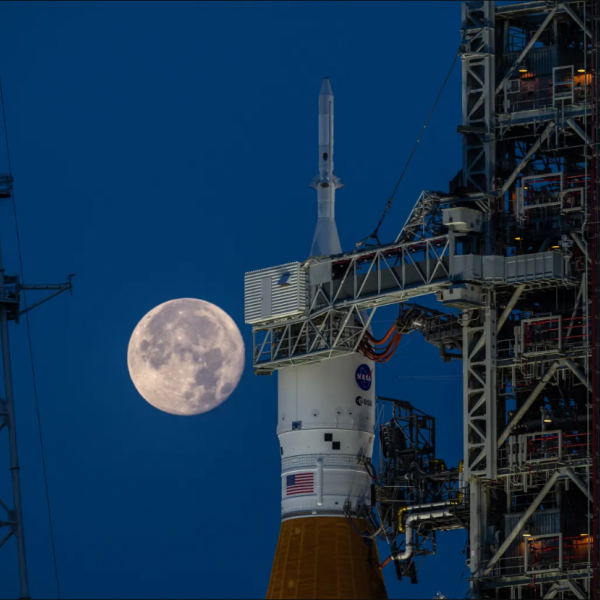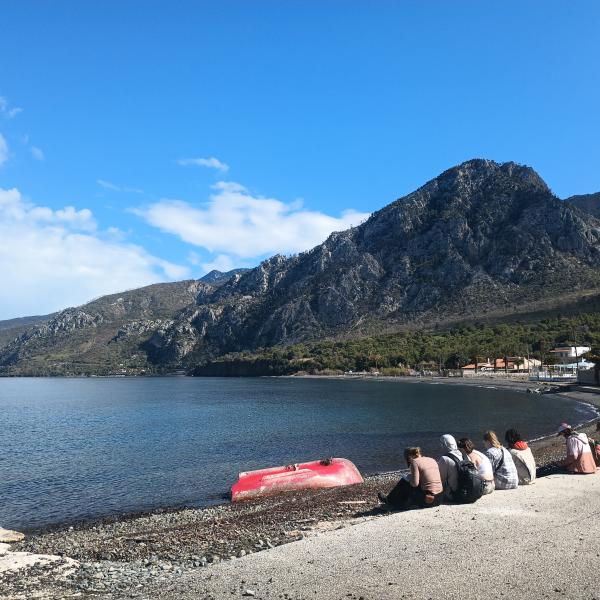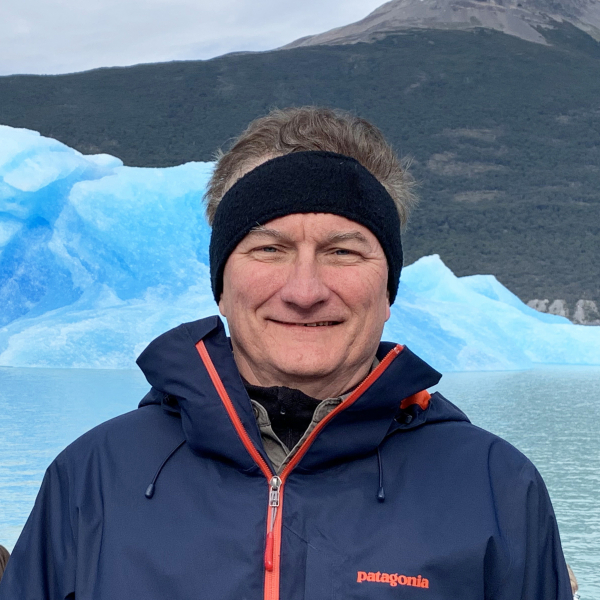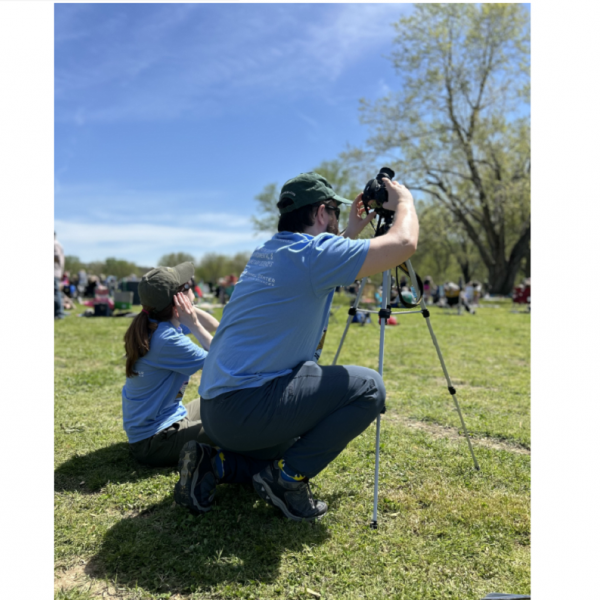The Human Brain: Episode #8
Back when his kids were in elementary school, biology professor Erik Herzog remembers taking a human brain into their classroom and watching the kids' faces light up with curiosity. Yet somewhere along the way, he knew, many kids get discouraged from pursuing careers in science - and this can be especially true for students from underrepresented backgrounds. Herzog, a neuroscientist who studies circadian rhythms, now manages many efforts across Washington University to support and encourage younger neuroscience researchers, from elementary school all the way through doctoral programs. Here he shares some of the outreach efforts across campus and the inspiration behind them, including the recently launched St. Louis Neuroscience Pipeline.
Full transcript
Claire Navarro: Thanks for listening to Hold That Thought. I’m Claire Navarro. I'm doing things a little bit differently today. I'm sitting down with Erik Herzog, who is a professor of biology and also director of the Neuroscience Pipeline Program here at Washington University in St. Louis. Over the past many weeks, we’ve been talking about neuroscience, and I became more and more interested in all of the wonderful outreach efforts going on at WashU. We’ve talked to a lot of scientists about their fascinating research, but a lot of these people and their graduate students are working towards passing that knowledge on and getting more and more people excited about neuroscience. And Dr. Herzog is heading up a lot of those efforts, so thank you so much for joining us!
Erik Herzog: It’s great to be here.
CN: So what is the Neuroscience Pipeline? How did it get started?
EH: The Neuroscience Pipeline, officially, is a NIH funded program to increase diversity in the neuroscience research area. In its bigger incarnation, the Neuroscience Pipeline in St. Louis is aimed at identifying people who might be interested in the neurosciences as early as middle school and then providing them with opportunities to get involved in neuroscience research and learn more about their minds, their brains, and mental health initiatives here in St. Louis, all the way up through becoming a researcher in the field, even a faculty member. We have opportunities for people here in St. Louis to get involved in neuroscience research from middle school, high school, college, graduate school, post-doctoral research, and into faculty and administration.
CN: And it is relatively new, correct?
EH: That’s right. The pipeline has been going on since the early 2000s in parts, and what we are trying to do is connect those pieces into a complete pipeline, something that will allow students to not fall between the gaps. So students might be interested in how they learn, for example, in high school and want to go on and get involved in learning about how we learn how we learn. What we do is try to provide them with opportunities to get involved in neuroscience research on, for example, learning and memory. We have opportunities now for high school students to get involved doing research during their summers. We have opportunities for undergraduates to get involved in research during the academic year and during the summers. We have opportunities for graduate students to be involved in research and also to reach out to the community and share their research with the public, and I know you are going to be talking with some of these groups over the next couple of weeks, so let me be specific: The Pipeline includes the Brain Discovery Group, which is a group that has developed a series of education components that they take to area schools, and they target middle schools. We also have the Young Scientist Program here at Washington University, which has a neuroscience outreach group, and they target area high schools and try to educate kids on why it is important to take care of your brain and what the teen brain does on things like drugs and why it may crave at very high speeds. And then we have our graduate school kids involved in something called the Amazing Brain Carnival, or the ABC. This is something that everybody in St. Louis can come and see at the Science Center. We work with Cindy Encarnacion at the St. Louis Science Center to put out exhibits twice a year where the graduate students develop exhibits for the public about their research. They help you understand, for example, how do we learn about multitasking in the brain. And then the thing that is officially called the St. Louis Neuroscience Pipeline, which is funded by The National Institute of Neurological Disorders, the NINDS, is a program that is designed to train undergraduates interested in the neurosciences over two years to get involved in research, to learn about the teen brain at a higher level than we would teach high school students, and to help them understand how they can successfully transition into graduate school and discover things about how the brain works.
CN: I would love to talk more about the St. Louis Neuroscience Pipeline. Why do you feel St. Louis is a great place to train and inspire these younger scientists?
EH: St. Louis is a great place in two ways. One is we have a remarkable neuroscience community here in St. Louis, and second, we have an opportunity in St. Louis to bring in new kinds of researchers to the field. St. Louis is a vibrant, diverse city, and many of the people who traditionally would not go into the neurosciences might be right here in St. Louis, and if we could encourage them to think about neuroscience research as a possible career choice, we think it could really improve the field of neuroscience where we work on very diverse issues, ranging from stroke, which disproportionately effects African Americans, and topics that might be of greater interest to young scientists, things like Bipolar Disorder, which tends to have onsets in the teen years. So we would like to take advantage of that vibrant, diverse community here in St. Louis. We have partnered with Harris-Stowe University here in St. Louis, and we have partnered with UMSL here in St. Louis to identify students who are talented and motivated that might not traditionally go into neuroscience. Because it was our first year, we didn’t have enough applicants from St. Louis, so yeah, we took students from all over the country. Those students came to Wash U, did research in our top-notch neuroscience research labs here at Washington University over the summer. They presented their research here in a undergraduate research symposium, and then they went on and presented their research at a national conference called the Society for Neuroscience, which is a big conference that brings together 30,000 of my closest friends, and these undergraduates presented their work there and networked with neuroscientists in their areas of interest. Then they went back to their home schools, UMSL, Wash U, Harris-Stowe, and other schools around the country, and during the school year, they’ve participating in a course that is being taught by Dr. Mitch Kundel. They either attended the class in person or they video conferenced in, and this course brings them together to talk about the latest discoveries in neuroscience where they read papers and learn how to critique and review scientific discoveries. And then those students will come back this summer for a second summer of research, and our hope is that these students are going to maintain their interest in going on in neuroscience research and start applying to graduate schools. This program is brand new, and we’re experimenting with ways to help students identify as neuroscientists, feel they are empowered to become neuroscientists even when they don’t see role models ahead of them that are like them, and feel they can break through that barrier and become neuroscientists.
CN: That must have just been thrilling for students to be able to do this type of research and actually be able to share it with professionals.
EH: Yeah! We’ve gotten some good feedback from students participating in the program who are actually being professionally assessed as we experiment with the best ways to get students to identify as neuroscientists. A couple things they highlighted were our program heavily emphasizes your ability to communicate your science both written and oral, so our students are challenged to present their research initially as a proposal—what I will be doing in the summer—and then in the summer as a summary of what they discovered. It’s challenging for an undergraduate to be able to say, “What can I conclude?” Many people will be able to tell you what they did, but the next step is to say what have you learned. Our students have really identified that as something the program does well.
CN: Do you have any examples of the types of questions they asked or the things the studied?
EH: Yeah, sure, this is fun. So one student came with a personal history of having had cancer, and she was very interested in studying brain cancer. So we connected her up with a lab that does research on brain cancer, and her research had two parts. One was working on a brain cancer model in mice, and her research identified that the tumor cells have daily rhythms in gene expression, which may make these cells sensitive to drugs at certain times of the day and not sensitive at other times in the day, suggesting a strategy for treating these cancers in a time specific way. The second part of her project was to begin to look at data from people with tumors that have been treated in the morning versus in the evening and trying to understand if there are different outcomes. The results there are too preliminary to reach to any conclusions, but the strategies are pretty clear for her now. A second student came in with very strong interests in understanding the genetic basis for a human neurologic disorder, like Alzheimer’s disease or in her case she worked on Parkinson’s disease, and she worked very closely with Dr. Carlos Cruchaga here in the Washington University Medical School. They were actually able to identify some genetic variants that are associated with the disease they were trying to study. The next step is to take those genetic variants and test whether they might be causal and risk factors for Parkinson’s. So all they way from cells in a dish to people.
CN: That’s amazing that that can happen over the course of a summer with undergraduate students.
EH: Yeah, so these students are really motivated, they work 40 hours a week in the lab, and they have great mentors who are really dedicated to their success.
CN: I would love to hear more about the class they take on the teen brain. I assume that curriculum was sort of based on the audience. What sort of things do they learn, and does that spark interest to learn about what’s going on in their own brain or in their brain’s not too distant past?
EH: Yeah, this is a great idea. On paper, what we said was teenagers should be interested in the brain because their brain is swamped with hormones making important life decisions about who they are going to love and who they are going to hate, and so we tried to design a course that would capture their interest and teach them at the same time some of the fundamental principals of neuroscience. We tried to make it a course that could be accomplished in a week, so when they arrive in the summer, this cohort of students who don’t know each other, finish everyday with two hours in the class room talking with a professor about the teen brain, and topics range from how neurons generate action potentials and send signals throughout the brain to how this might be different in a young brain, in an adolescent brain, and in an adult brain. How synaptic connections, the way neurons communicate with each other, might be changing with age. They read a book that was developed for undergraduates at Harvard called Creating Mind, a book by Dr. John Dowling, and they find that this book—they can finish it in a week—really helps them frame their research in the context of a larger neuroscience field. I think I also learned that the course itself doesn’t have enough teen brain in it; they want more about their own brains, and so this summer, we are going to be experimenting with some new content about how certain drugs work and how decisions are different in the teen brain compared to others.
CN: So you direct this program. What made you excited about starting this program? Was it something about the way you first got excited about neuroscience?
EH: I think what got me involved was a very long, slow progression. I came to Washington University in 2000, and at that time I had two young boys. I would occasionally visit their classrooms and bring a human brain to their classrooms. I could see their excitement at being able to say they were holding a human brain and learn a little bit about neuroscience. And as a neuroscientist, I know what gets me excited about my research, and I want to share that enthusiasm. Over the years graduate students and other students have encouraged me to do more and more, and at one point, a graduate student working in my lab encouraged me to found the St. Louis Chapter for the Society for Neuroscience. So we started doing more outreach activities where we worked with the St. Louis Science Center, where we worked with the medical school, and we worked with various student groups at Washington University, and we just kept growing. Groups like the ABC and The Brain Discovery were student-driven initiatives that I just helped foster; I just helped make them happen, and I started to realize, “Wait, we are creating a pipeline here. Let’s make this formal.” So we wrote the most recent NIH grant, which formalizes our goal to create something that doesn’t leak. It gives students to move from each stage in their training to the next stage seamlessly and identify themselves as neuroscientists.
CN: It sounds like so far it has been very successful, and it is only going to do more from here.
EH: Oh yeah, it’s really a blast. I hope everybody will come see us at the St. Louis Science Center for Health Fest or Neuro Day.




